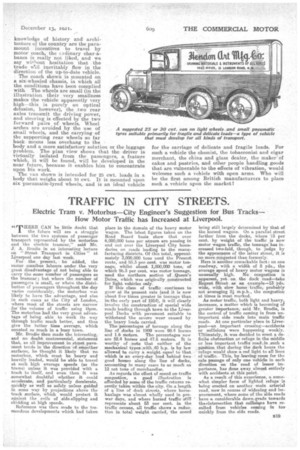TRAFFIC IN CITY STREETS.
Page 17

If you've noticed an error in this article please click here to report it so we can fix it.
Electric Tram v. Motorbus—City Engineer's Suggestion for Bus Tracks— How Motor Traffic has Increased at Liverpool.
rp HERE CAN be little doubt that I the future will see a struggle between the two systems of passenger transport represented by the motorbus and the electric tramcar," said Mr. J. A. Brodie in an interesting lecture on "Street Transport in Cities " at Liverpool one day' Last week. For the present, he added, the motor . omnibus labours under the very great disadvantage of not being able to carry the same number of passengers as the tramcar; but where the number of passengers is small, or where the distribution of passengers throughout the day varies considerably, the motorbus was likely to have the advantage, and also in such cases as the City of London, where most of the streets are narrow Jarthe volume of traffic using them. The motorbus had the very great advantage of being able to work its way through traffic much better, and thus give the better time average, which counted so much in a busy town.
Mr. Brodie then made the interesting, and no doubt, controversial, statement that, as all improvement in stae_ekpavement tends in the direction-of. smoother surfaces, he thought it likely, that re motorbus, which must be heavy and heavily loaded, would be able to travel at such high average speeds {as the trams') unless it was provided with a track to itself, and even then it was somewhat doubtful whether it could aceelerate., and particularly decelerate, quickly as well as aafely unless gnideal in some way by projections above the track surface, which would protect it against the evils of aide-slipping and skidding at high speeds.
Reference was then made to the tremendous developments which had taken
place in the domain of the heavy motor wagon. The latest figures taken on the Read Board basis show that over 6,000,000 tens per annum are passing in and out over the Liverpool City boundaries on roads leading to the Immofactoring districts. Of this total, approximately 3,000,000 tons used the Prescot route, and 95.3 per. cent. Was motor tonnage, whilst abut. 1,500,000 tons, of which 96.3 per cent, was motor tonnage, used the northern Section of Queen's Drive, which was originally conatructed for light vehicles only. If this class of traffic continues to grow at its present rate (and it is now about five times greater in tonnage than in tha early part of 1914), it will clearly involve the construction of special wide roads leading through town to the Liverpool Docks with pavement suitable to withstand the severe wear caused by the heavy toads carried. The percentages of tonnage along the line of decks in 1909 were 98,4 horses and 1.6 masters. The percentages now are 52.4 horses and 47.6 motors. It is worthy of v note that neither of the mechanical types ,with. 40 h.p. is by law allowed to carry a weight equal to that which ia an every-day load behind twogood buses along the line of docks, amounting in many cases to as much as 12 net, tons of merchandise.
As regards the effect of speed on traffic congestion, a good illustration is afforded by some of the traffic returns recently taken within the city. On a length of a has of dock streets, where horsehaulage was almost wholly used in prewar days, and where horsed traffic still represents about 53 per cent, in the traffic census, all traffic shows a reduction in total weiaht carried, 'the speed being still largely determined by that of the horsed wagons. On a parallel street farther from the docks, where 73 per cent, by weight of the traffic is now motor wagon traffic, the tonnagehas increased two-fold, though, to judge by the appearance of tho latter street, it is no more oongested than formerly.
Here is another remarkable fact: on one roadway, with a width of 8 yds., the average speed of heavy motor wagons is unusually high. No congestion is apparent, yet on the dock road—take Regent Street as an example-43 yds. wide, with slow horse traffic, probably not averaging 2L m.p.h., the congestion at times is most marked.
As motor traffic, both light arid heavy, increases, a matter which is becoming of greater importance, said Mr. Brodie, is the control of traffic coming in from unimportant side roads into main traffic roads. At one particular place in Liverpool—an important crossing—accidents or collisions were happening .weekly. Ultimately, it was decided to erect a definite obstruction or refuge in the middle or less important traffic roacLin such position that during the dark hours the refuge would show a red light to all lines of.traffie. This, by leaving room for the safe passage of only one vehicle in each direction on the road of leaser importance, has done away almost entirely with accidents at this point.
As a reault of this experience, a somewhat simpler form of lighted refuge' is being erected on another main arterial road, now in course of widening and improvement, where some of the side roads have a considerable down-Trade towards theaiintersection that collisions have resulted from vehicles coming in too Quickly from the side roads.
































